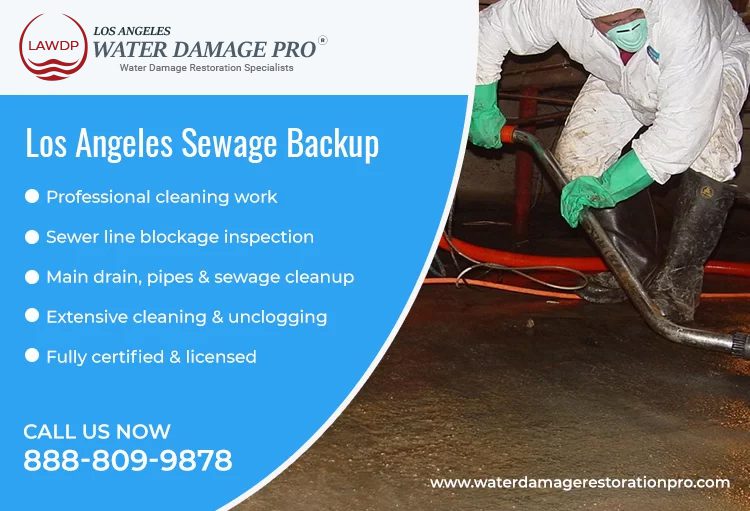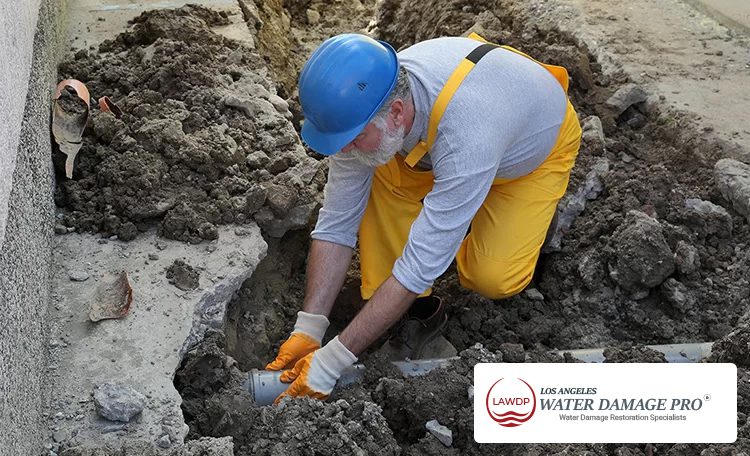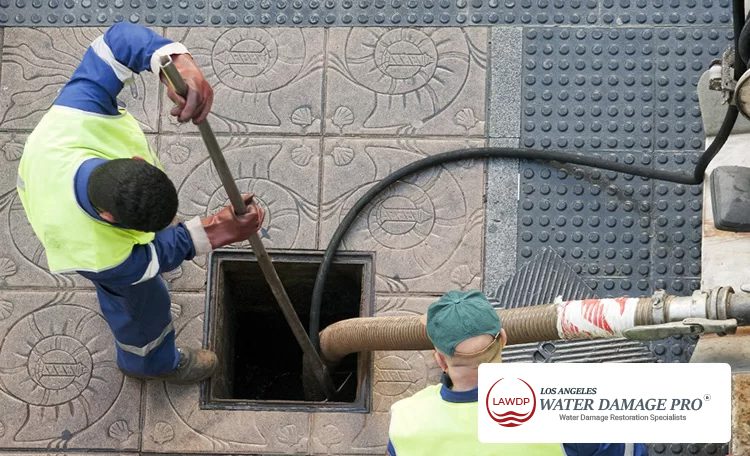- 24/7 Water Damage Emergency
- Licensed and Insured
- FREE Estimates
- Direct Insurance Billing
- Insurance Claims
It becomes absolutely necessary to go for a yearly cleanup of your sewer line, main drain and drainage pipes that lead to the underground drains. This is to prevent water clogging & overflowing. It so happens that with the passage of time, various foreign particles like dirt, debris, plastic waste, wood, roots, stems, grease, oil and food matter get accumulated in the drains, and that is what results in clogging. Your home interiors, including the basement, bathroom, kitchen and rooms get flooded, and the stench and foul odor are unbearable.

This is exactly when you need to go for a Los Angeles sewage backup service from a professional like us. At Water Damage Restoration Pro, we help clear all the blockages and clogging by using advanced technology like a camera that is inserted into the sewer line or durian for knowing the exact amount of blockage and the area where the blockage has occurred. This way, we help a residence have a free-flowing drainage system, even when it rains heavily. Such an unclogging service is required just before and after it rains, or any time of the year, to keep your drains and sewage line free from any known blockage.
Here is an outline of the timeline of damage caused by sewage backup:
| Time Since Backup | Impact |
| 0-24 Hours | Standing water, foul odor, possible health hazards, potential damage to belongings |
| 24-48 Hours | Bacteria and mold growth, potential health hazards, damage to drywall, flooring, and wood |
| 2-7 Days | Severe mold growth, structural damage, risk of electrical fires, health hazards |
| 1-2 Weeks | Continued mold growth, irreversible damage to structural components and belongings |
| More than 2 Weeks | Severe structural damage, total loss of affected items, and health hazards, which leads a significant expense for restoration and cleanup |
Please note that the timeline of damage may vary depending on factors such as the severity of the backup, the extent of the contamination, and the humidity and temperature of the affected area. It’s important to address sewage backups as soon as possible to minimize the damage and potential health hazards.
If your clogged and overflowing drains are kept neglected for a long, it can create serious health-related problems. Therefore, it is always advised to go for a periodic Los Angeles sewage backup service in order to prevent any kind of clogging or blockage that result in the harmful bacteria-infested water overflowing or spilling over your home interiors and exteriors.
This can cause serious health related issues like Diarrhea, Jaundice, nausea, vomiting, fever, serious bowel related problems and skin allergies. Let’s understand what the other problems it might bring.
As and when you notice visible signs of water overflowing in some key areas, like in the bathroom, in the bathtub, in the sinks, wash basins or in your toilet, you must understand that there’s an issue of clogging which needs to be rectified. Similarly, when you notice the kitchen drainage pipes overflowing the water is not able to pass through freely from the wash basin of the sink, you immediately need to call in an expert in sewage cleaning and backup.
As we’re a specialist in sewage backup and swerve line cleaning, we can find out the exact place or location of the blockage. In the house exteriors too, when you notice the lawn of the backyard is getting flooded with dirty water from the overflowing drains, it’s time to call an expert sewage cleaner to unclog the drains and free all the dirt, debris, filth, waste materials, food leftovers and other foreign objects that have been blocking the smooth passage and flow of water.
When you notice that your basement is flooded or there’s a foul odor coming from the ground floor near the bathroom, it means there’s a problem with your sewage line, and that needs to be immediately cleaned and unclogged. Call us at 888-809-9878 to know more about our services.
What causes the main sewer line to back up? Unfortunately, there are a variety of causes of sewage buildup that can lead to plumbing problems in your home. Identifying the cause of the sewer overflow will help you fix the problem in a timely manner.

Your home’s main sewer line can become clogged or blocked just as easily as the individual drain pipes in your home. The main sewer line is only big enough for human waste and toilet paper to be washed. So if other items get thrown or poured down the drain that shouldn’t, they can create a backup.
If the backup is from an individual drain clog, you will only experience plumbing problems with that specific drain. However, if the backup is from the main sewer line, various areas of your home will experience plumbing problems, such as multiple toilets or drains.
Trees and other plants seek moisture and other nutrients near the sewer line, especially during dry seasons or droughts. Over time, tree roots will grow over or around sewer pipes, causing cracks to form.
They are also extremely heavy, so they tend to grow and wrap around sewer lines, eventually crushing pipes. Roots can infiltrate these cracks and create a blockage, leading to a buildup of sewage.
Sewer pipes are susceptible to damage from earth movement and insufficient soil support, leading to broken and collapsed pipes. This is another common problem in older homes that have old iron or clay plumbing systems.
A backup of sewage can occur due to a broken, cracked, or collapsed line. Iron pipes also tend to deteriorate over time, causing corrosion that eats away at the pipes.
Although public sewer systems are made to handle large amounts of water, they still have limited capacity. Heavy rains, especially when they last longer, can cause major problems for sewage systems. If rain causes the system to exceed its capacity limit, excess water can flow back into residential homes.
Many older sewer systems have cast iron and clay pipes. While these materials are relatively durable, they are not made to last forever. Even PVC pipes will deteriorate over time and will eventually collapse. Many homes experience sewage overflows when sewer systems get too old.
Sometimes sewer overflows can be caused by a problem outside of your home, such as a city sewer blockage. If you’re wondering what causes sewage to build up in basements, municipal sewer problems are often to blame. While these problems are usually found and treated fairly quickly, they can still affect nearby residential sewer lines.
Unfortunately, there is not much you can do about this type of sewer problem. Homeowners should contact their local city or municipality and work with them directly to fix the problem.
While many home sewage overflows can’t be completely prevented, there are some steps homeowners can take to avoid plumbing and sewer problems in the future.
Many sewer problems, such as those caused by a clog or blockage, can be easily avoided by performing routine pipe maintenance and care.
To avoid future backups, here are some tips to follow:

| Toilet unclogging | Clearing the toilet pipes from all debris |
| Bathtub unclogging | Clearing the bathtub drainage pipes |
| Underground sewer cleaning | Cleaning underground sewer lines that overflow |
| Main drain & sewage line | Unclogging the main drain from all waste |
It is always advised to call a professional plumber or a certified water damage restoration company like us that can help drain out all the sewage water and restore the place i n its original state and condition, by properly sanitizing, cleaning & decontaminating.
when you notice all the waste water overflowing out of the darain, toilet or bathtub and overflowing your backyard, kitchen, bathroom or basement, it is definitely an issue related to main drain or sewer line blockage which needs to be unclogged immediately.
You need to immediately contact your local plumbing agency or a water damage restoration specialist like us that can arrive at your property, look into the actual situation, understand the damage caused, get to know the root cause of the problem, and thereafter go for unclogging or removing the blockage from the drains, pipes and underground sewage lines.
It is quite a tricky and risky affair to do the sewage cleanup service by yourself, unless you’re fully qualified, certified and experienced for such kind of cleaning jobs that involves a fair amount of expertise and risk of contamination. It’s always advised to call a sewer line cleaning expert.
The duration of sewage backup remediation can vary depending on several factors, such as the extent of the damage, the size of the affected area, and the type of materials that were contaminated.
In general, the sewage backup remediation process can take anywhere from a few days to a week or more. The process may involve several stages, including water extraction, disinfection, cleaning, and drying.
If the sewage backup has caused significant damage to the home’s structural components or if mold growth is present, the remediation process may take longer. Additionally, if there are any delays in obtaining necessary permits or scheduling inspections, this can also prolong the remediation process.
Here are some of the different types of equipment we use for sewage backup projects:
Wet/dry vacuums: These powerful vacuums are designed to handle both wet and dry materials, making them effective for removing sewage-contaminated water and debris.
Industrial fans: These fans are used to help dry out affected areas after cleaning and disinfecting.
Dehumidifiers: Dehumidifiers are used to reduce moisture levels in the air and prevent mold growth.
Chemical disinfectants: We use EPA-approved chemical disinfectants to kill any remaining bacteria and viruses.
Personal protective equipment (PPE): Technicians will wear PPE, such as gloves, eye protection, and respirators to protect themselves from exposure to harmful pathogens.
HEPA air filters: HEPA filters are used to filter out contaminants from the air.
Moisture meters: These tools are used to measure moisture levels in walls, floors, and other surfaces to ensure they are dry and free of moisture.
Use of Personal Protective Equipment (PPE): All our technicians come equipped with PPE, such as gloves, safety glasses, hard hats, and respirators, to protect them from hazards that may be present during the cleanup process.
Hazard Assessment: A hazard assessment of the work area will be conducted before beginning the cleanup process. This assessment will identify any potential hazards, such as chemicals, sharp objects, or electrical hazards, and the necessary precautions to be taken.
Training: Our technicians are properly trained on the hazards and safety procedures that need to be followed. This includes training on the proper use of equipment and PPE.
Equipment Maintenance: All equipment used during the cleanup process will be in good working condition and properly maintained to prevent accidents.
Disposal: All waste and debris generated during the cleanup process will be properly disposed of according to local regulations and guidelines.